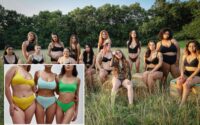Supermodels ditch ‘partying’ diet of booze, drugs and cigs
When the Sports Illustrated Swimsuit Issue dropped last week, it was essentially a report on the state of the modeling world.
“Now the industry is about body positivity and acceptance,” said Craig Lawrence, director at Ford Models and a 31-year industry veteran. “Look at the four people they put on the SI cover: [influencer] Kim Kardashian, a 70-something Maye Musk, Ciara, a singer, and Yumi Nu, who is an Asian curve model. SI pushed the envelope and has gone places before it was [popular]. Now, of course, people are on the bandwagon.”
For decades, the modeling world was defined by glamorous exclusivity: impossibly thin models in designer duds, consuming designer drugs, booze and cigarettes. They were seen and certainly not heard.
In the new issue of British Vogue, Gisele Bündchen opened up about her early career and diet of wine and cancer sticks.


“From the outside, it looked like I had everything and I was just 22 years old. On the inside, I felt as if I’d hit rock bottom. I was starting my day with a mocha Frappuccino with whipped cream and three cigarettes, then drinking a bottle of wine every night. Imagine what that was doing to my mind.”
And in 2013, former Vogue Australia editor Kirstie Clements wrote a tell-all with stories of starving models, most notably that catwalkers were eating paper towels to be thin. Kate Moss’ 2005 cocaine scandal ruled headlines for weeks and Naomi Campbell has spoken out about beating her addiction to coke and booze.
Bündchen, of course, cleaned up her act to eventually become — along with Tom Brady — one half of the world’s most insanely disciplined wellness couples. She saw a naturopath who suggested she remove sugar, grains, dairy, caffeine, alcohol and cigarettes from her diet.

Current model of the moment Bella Hadid told In Style in January she is now sober. “I loved alcohol and it got to the point where I even started canceling nights that I felt I wouldn’t be able to control myself,” the 25-year-old said, adding that she was dealing with booze-fueled 3 a.m. anxiety attacks.
Health, not hard-partying, is now the norm.
“There was a time when heroin chic was part of the business,” said Lawrence. “My first agency, we represented Jaime King, who was very forthcoming about her drug problem. And back then it was glorified.”
He added: “Years ago, you’d see models partying, not adhering to a healthy lifestyle. Now you see models all into yoga, fitness and healthy eating.”

Lucie Beatrix, 33, is one of the former. While living in NYC model apartments, the St. Louis native, who modeled for a decade, survived on cigarettes and a bottle of wine for dinner, so that she could easily pass out.
“I learned from my roommates,” said Beatrix, who has graced the cover of Elle Mexico, among others. “The skinnier I was, the more money I made. It was applauded.”
But social media and social justice have changed our society. The once discerning industry has put out a welcome mat to many sizes and ethnicities, and encouraged models to speak out on their pet issues.


“I remember when I was getting out of the industry, I was excited to see the body positivity stuff. I was glad to see bigger girls being embraced instead of scolded,” said Beatrix, who is now sober and a competitive runner.
“It’s like going to a fast-food restaurant. In the beginning, you only had the burger. Then they added a turkey burger. Now they have a burger, a veggie, a turkey and an impossible burger. That is the way of the industry. There will always be the client that wants the size two or size four, but what we are seeing is you can’t just cater to one thing,” said Lawrence.
The agent has seen the changing nature of the curve industry, noting when Ashley Graham was at his agency, she was not an overnight success. “It took a while,” he said. “I remember Victoria’s Secret saying they would not use curve models because VS is about aspiration. Personally, I think millions of girls that might not have thought of themselves as models and presto, those doors are open. Ten years ago, Yumi Nu might not be considered.”

He noted that high social media followers are just as desirable now as a size zero waist was 10 years ago.
“A lot of these brands are looking at the algorithms. The influencers have become what the actors were in the ’90s when magazines started replacing models with actors,” he said.
And brands are no longer all about blue-eyed blondes.

“I have friends in the business all around the world and everyone wants the ethnically ambiguous girl. It used to be about a girl who looked like Christie Brinkley. That message [of ethnic ambiguity] is amplified louder than ever.”
Beatrix noted that models are encouraged to be open about their issues — even scoring points and magazine covers or campaigns for their radical transparency.
“When I lost weight to hold up my end of the contract, I got extremely skinny, and it was applauded left and right. When I came out and said I had a problem, everyone around me told me not to talk about it. Now it’s totally different.”
Or as Lawrence noted: “Models are navigating their own journeys.”


